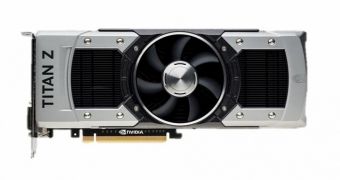Yesterday, NVIDIA's dual-GPU GeForce GTX Titan Z graphics card started selling, for a lot more money than the already exorbitant “standard” price, and now we bring the second part of the confirmation that the card isn't all it's cracked up to be.
It might be owed to the fact that NVIDIA hasn't finished some sort of super-driver for the thing, but the behemoth doesn't really run as well as it should in order to justify the price of $3,000 / €3,000.
Which is really bad, seeing as how the current price of the GeForce GTX Titan Z is of $4,000 / €4,000.
NVIDIA might be able to reel in customers because the newcomer isn't just a gaming board, but a professional one too.
The CUDA compute capabilities of the GK110 graphics processing unit make it good for video editing and the like, similar to the Quadro series.
That will only take customers away from the professional GPU line, though, so NVIDIA probably won't gain that much from that avenue, if anything.
The saving grace of the Titan Z is that it's the first 5K-compatible graphics card in the world (5100 x 2700 pixels), but one has to wonder if that's really enough to sell the product on its own.
Especially now that, in a review posted by Dr. Lee (DGLee), the newcomer doesn't really perform at an awe-inspiring level.
Well, it does, but the huge price more than pops the bubble of admiration that may build around the name of the product. At least the triple-slot cooler is supposedly silent in addition to good looking, though we imagine that buyers will prefer to substitute it for a water block regardless.
After all, the first direct competitor from AMD (Radeon R9 295 X2, 14.2 billion total transistors) is quite close, performance-wise, (and has only 8 GB VRAM instead of 12 GB), but costs just $1,500 / €1,500.
And to think that one thousand dollars/euro used to be considered the top price on the video card industry. Times sure have changed.
In case you want a brief rundown of the dual-GK110-350-B1 video card, here are the primary parts of the twice delayed product: 5,760 CUDA cores, 448 TMUs, 96 ROPs, two 384-bit memory interfaces (each driving 6 GB GDDR5 VRAM), and clocks of 705 MHz for the GPUs (876 MHz boost) and 7 GHz for the memory.
All in all, the board is capable of single precision performance of 8.1 TFlops and double precision performance of 2.3 TFlops.

 14 DAY TRIAL //
14 DAY TRIAL //